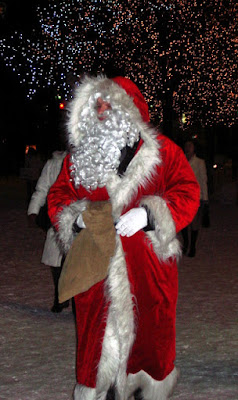 5th November, 2003 -
5th November, 2003 - T-chan's family had prepared something special for our last week in Sapporo. The whole family including T-chan's brother H-kun were going to go to
Shikotsuko to visit one of the nice onsen that sits on the lakes edge, called
Marukoma Onsen (sorry the website's only in Japanese)
This onsen had a great view out over the lake - which like Touyako was actually a caldera lake formed from the remaining crater from a former cataclysmic eruption. This area is great for touring around in a car, as you can drive around the whole lake, or go for a bush-walk during the day.
The onsen itself was more the traditional onsen with both inside and outside onsen. The room itself was a large one (easily fitting 5 adults) which actually looks quite open and sparsely decorated during the day. As eveing approaches they start to get the bedding ready. Futons (which are the mattresses) that are stored in the room wardrobes.
The sunset fades to a glorious twilight... the outside onsen is inviting in the clear Autumn night's crisp air. Unfortunately, it's bad form to take photos in the onsen (as you can imagine, people get a little upset when a camera comes out), so I don't have any photos of the inside or outside onsen. One question might be - so what do you do in an onsen? Mostly... nothing. After cleaning, generally it revolves around lying in the 40-44degC (104-111degF) baths... but it's relaxing once you get into the swing of it.
And Shikotsuko has a charm all of it's own. Like Touyako it's a deep lake, and there is definitely a calming presence about the place.
The evening meal! Ittadakimasu (let's dig in!). The clothes (a light yukata with a heavier haori) is provided for your relaxation... so no, we haven't joined the Green Jackets cult.... or have we?...
Oishisou!


Ten things to remember when visiting onsen...
1. Onsen and Sento (Sento are generally artificially heated baths) normally do not appreciate tattoos - and may in fact prohibit people with tattoos. Tattoos are associated with criminal elements (e.g. the Yakuza).
2. Don't forget to leave your shoes outside (usually in a locker) - indeed in hotels you'll often come to the onsen in yukata (see below)... Leave all clothes in the small wicker baskets provided. Some onsen offer wrist straps for keys for security.
3. Check that you're going into the correct bath - onsen are normally single-sex now and you can easily tell by the colour of the noren (curtain): blue = men, red = women (no prizes). Be careful however - it's common for the baths to swap depending on the time of day
4. Come into the onsen area essentially naked (bring along the small modesty towel... it seconds as funky hat). Shampoo/soap is supplied at the washing seats. Actually that's the badge of the ojisan (older man)... wearing his towel proudly on his head as he's sinking chin deep into water. Seriously - there's not many other places to put the towel as keeping it on the ground would be considered unclean.
5. Wash yourself at the seated shower area (easy to see)... and wash EVERYWHERE. Onsen are not baths for cleaning - you are expected to be clean already. Remove all the suds before you get in.
6. Don't stay too long in any one bath... temperature differential is good for circulation, so getting up and moving about (to different temperature baths for example) is good for your health
7. There's often a basin with cooler water - use the ladle to pour this over yourself (good for getting that cooling to stimulate the circulation).
8. Whilst you want change baths/temperature... don't jump in and out of the baths. Onsen is a soothing time for care-worn Japanese - take things slowly. I'm not sure if there's etiquette involved in where you sit in an onsen, but I know personal space shrinks in the hot, pungent water.
9. Don't forget to hydrate - sitting in a hot bath for long periods can be very de-hydrating. For some reason, a lot of onsen/sento have weighing scales that Japanese religiously use before and after (especially if using the Sauna). Onsen are synonymous with drinking alcohol - remember this is BAD for hydration (and drinks are typically banned from the onsen itself).
10. Try not to wash/shower after coming out of the onsen... this may seem strange if you're hot and sweaty... but the onsen water is thought to be very good for the skin... However - do what you feel comfortable with.
Check out
here for a really good resource on the do's and don'ts of onsen etiquette.
After a late night of eating, drinking, and dancing (ok - that was perhaps mostly after the drinking), the morning light shines through strong. Before you know it, the bedding's been taken away, and it's time to head out to meet a new day. Unfortunately, the days have disappeared... and it's now time to come back to Australia.

This is the last post for our second trip to Japan together in 2003. We started the trip (months earlier when T-chan had to go back to Japan to apply for a fiance visa) not knowing if she would be approved for immigration to Australia. It was a stressful time, and quite unlike our first trip which was more about a crazy whirlwind tour of Japan. This time around we were living at home, our second home... and developing our own Japanese Ties.
Thank you T-chan's parents for looking after me so well - and thankyou for agreeing to let me marry your daughter. Arigatou otousan to okaasan!.




